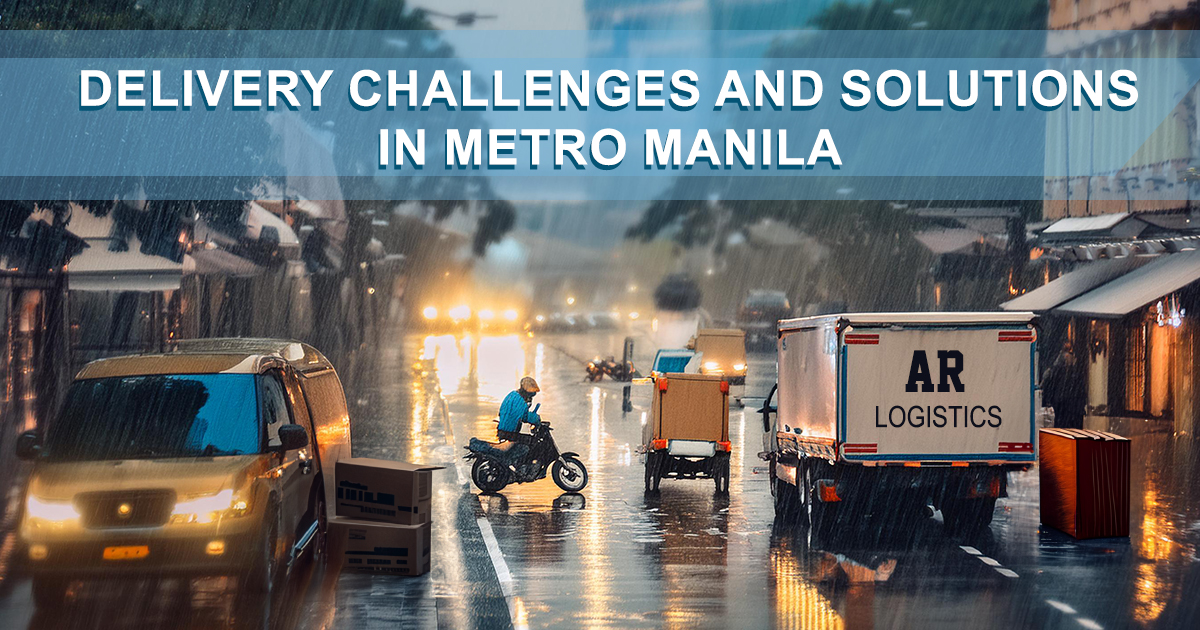
Metro Manila gets hit hard by heavy rains and storms, which really mess up daily life and business. It’s a key economic hub, but it struggles with nasty traffic and flooding, especially when the monsoons roll in.
How is the Rainy Season Affecting Transportation in the Philippines?
Typhoons frequently occur around late May to early October, adding to the already erratic weather. All this rain and wind can really mess with getting around – roads get flooded, traffic piles up, and deliveries get delayed.
Flood-prone areas such as Taft Avenue, España Boulevard, and G. Araneta Avenue become nearly impassable, further stressing an already strained transportation network. These seasonal delivery challenges call for proactive measures and adaptive strategies from businesses to ensure timely and safe deliveries.
Flooding and poor road conditions during heavy rains pose substantial risks to both goods and personnel. Businesses are compelled to adopt various protective measures, including advanced route planning, utilization of reliable delivery partners, and enhanced packaging to safeguard against water damage.
Delivery companies like Transportify employ real-time tracking and flexible delivery options to navigate these delivery challenges effectively. Additionally, driver safety protocols and proper equipment are crucial to mitigate health risks for delivery personnel, whose exposure to harsh weather conditions can lead to serious ailments and operational inefficiencies.
Overview of Metro Manila
Metro Manila or the National Capital Region (NCR), is highly populated with a population of around 15 million, and its citizens contribute about 35% of the country’s GDP.
This high population density, combined with rapid urban development, has led to significant delivery challenges, including traffic congestion and recurrent flooding.
Demographics and Urbanization
Of the nearly 15 million people residing in Metro Manila, approximately 3 million live in informal settlements. These informal communities are often found in disaster-prone areas, such as the city’s many waterways, which are susceptible to rapid flooding during monsoonal rains.
The migration to Metro Manila over the last several decades has been driven by the search for employment, education, and better opportunities, attracting millions from the countryside and various islands.
Flood Management and Climate Impact
As demonstrated by Tropical Storm Ondoy (Ketsana) in 2009, which caused damage and losses equal to 2.7 percent of the nation’s GDP, the regular flooding in Metro Manila has serious economic consequences.
In response, the World Bank assisted the Philippine government in creating the Metro Manila Flood Management Master Plan, which intends to put policies like building dams and enhancing urban drainage systems into action in order to control significant flood disasters.
Impact of the Rainy Season on Deliveries
Heavy rains, floods, and unpredictable weather patterns can disrupt transportation routes, delay shipments, and endanger both goods and personnel.
Flooding and Road Conditions
Floods during rainy season are no joke. They can wreck your stuff at home, like carpets and furniture, but they can also be deadly and destroy entire buildings. It’s not just cities that suffer – rural areas get hit too. Landslides and flooded roads cause all sorts of problems, from late deliveries to dangerous driving conditions.
In Metro Manila, intermittent rains can submerge entire parts of the city, paralyzing traffic and public transportation. For instance, during one heavy rain event, the South Luzon Expressway (SLEX) experienced massive traffic buildups, with the tail end of the queue extending up to 17.2 kilometers.
Protecting Goods and Ensuring Delivery
To mitigate these delivery challenges, businesses must adopt proactive measures. Using weather forecasts to plan shipments and choosing alternative routes can help prevent delays and damages. Reliable delivery partners are essential for navigating the rainy season successfully.
Select a logistics provider that provides scheduled drops and same-day delivery, as well as real-time tracking so that customers and businesses can keep an eye on their products during the delivery process.
Personal and Personnel Safety
In addition to having an effect on goods, the wet season puts delivery workers’ health at danger. Rainy weather raises the risk of colds, the flu, and other weather-related illnesses. Giving delivery personnel the tools and medical support they need is essential, even though it can increase operating expenses.
Traffic Congestion and Route Optimization
The rapid economic development in Metro Manila has led to heavy traffic congestion, especially during the rainy season. National routes are in good condition; however, a significant percentage of maintenance status reports indicate poor conditions for National Highways 1 and 2.
Through an awareness of how the rainy season affects delivery and the implementation of strong strategies, companies may effectively manage these obstacles and guarantee that items arrive at their destinations promptly and safely.
Delivery Service Providers You Can Rely On During the Rainy Season in Metro Manila
During the rainy season, you should select a reliable logistics company in Metro Manila for your delivery among the large pool of delivery service providers. Here are five reputable delivery service providers that stand out for their reliability and efficiency:
-
Transportify

As a leader in the logistics industry, Transportify offers extensive services tailored for the rainy season. With an advanced network and technology, they ensure timely deliveries despite adverse weather conditions. Their real-time tracking system and flexible delivery options make them a top choice for businesses needing resilient logistics solutions.
- Lalamove

Lalamove offers tailored solutions for the rainy season, focusing on safety and promptness. Their weather-adaptive strategies and well-trained personnel ensure that your goods are delivered safely based on schedule, regardless of the weather conditions.
- LBC Express

LBC Express is renowned for its wide-reaching domestic network, making it a reliable option during the rainy season. Their experience in handling complex deliveries ensures that your packages are safeguarded against the elements, with contingency plans in place to navigate flooded routes effectively.
- J&T Express

J&T Express utilizes an extensive local knowledge and technological infrastructure to maintain delivery efficiency, even during heavy rains. Their waterproof packaging and strategic hub locations help minimize delays caused by flooding and traffic disruptions.
- GrabExpress

GrabExpress provides flexible same-day delivery services, which are invaluable during the rainy season when traditional delivery schedules can be unpredictable. Their mobile platform allows for real-time adjustments and communication, ensuring both senders and recipients are updated about the status of their deliveries.
SEE ALSO:
